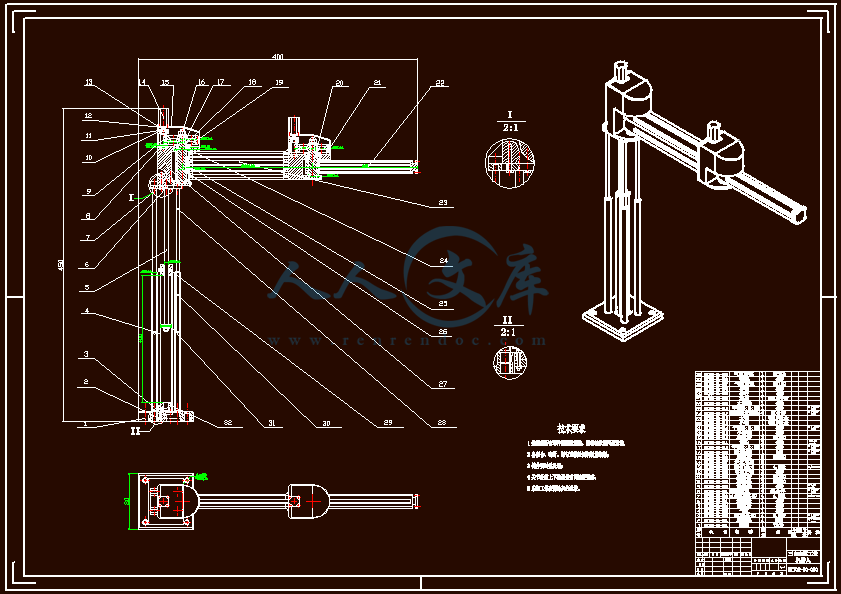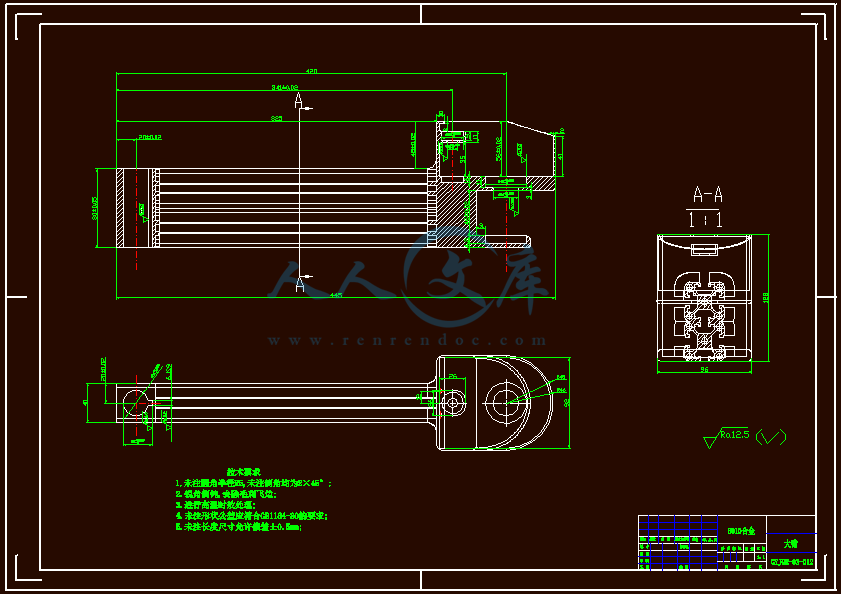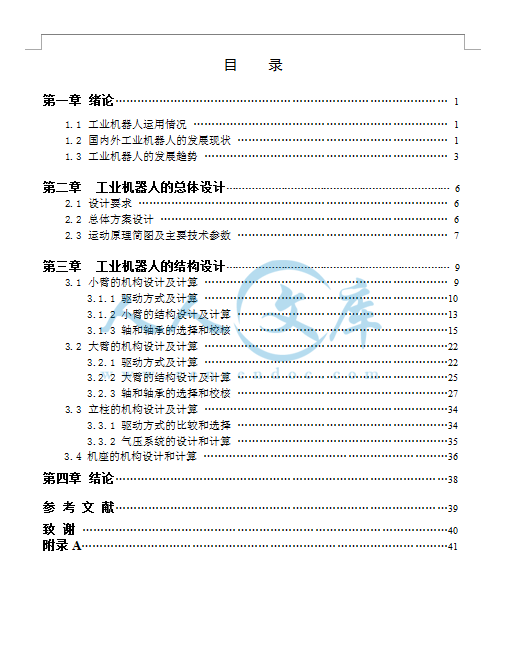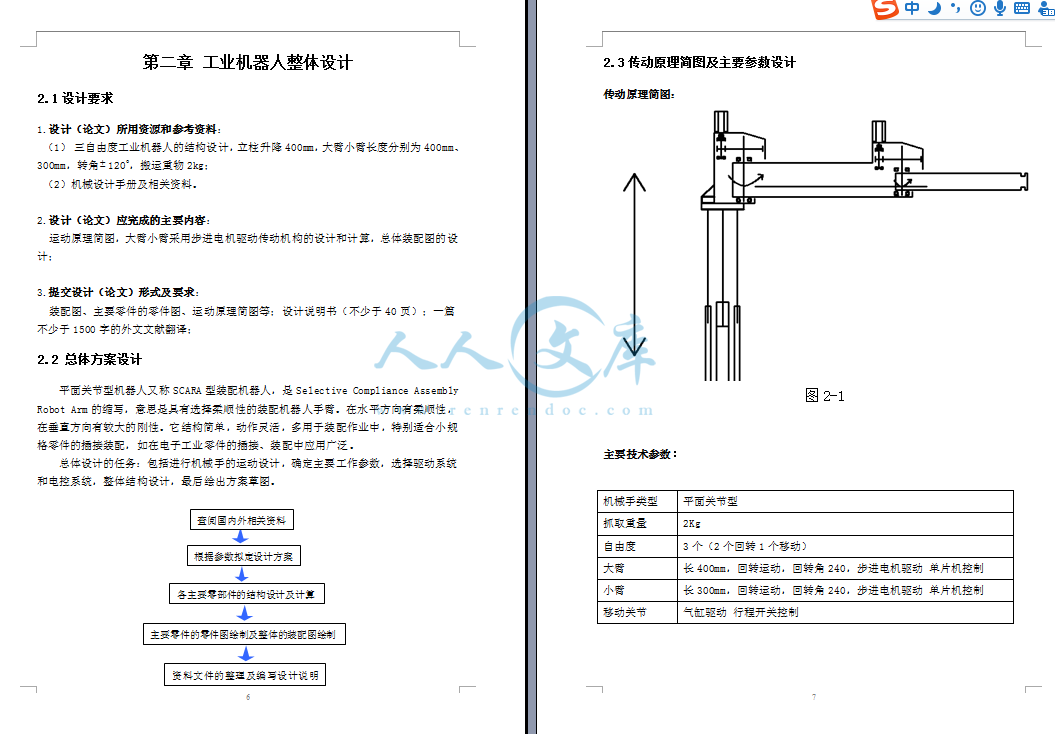三自由度工业机器人的结构设计【CAD图纸+solidworks三维模型+说明书】
收藏
资源目录

压缩包内文档预览:
编号:6099572
类型:共享资源
大小:8.94MB
格式:ZIP
上传时间:2017-11-16
上传人:机****料
认证信息
个人认证
高**(实名认证)
河南
IP属地:河南
50
积分
- 关 键 词:
-
自由度
工业
机器人
结构设计
cad
图纸
solidworks
三维
模型
说明书
仿单
- 资源描述:
-








- 内容简介:
-
1附录外文文献:Space Robot Path Planningfor Collision AvoidanceYuya Yanoshita and Shinichi TsudaAbstract This paper deals with a path planning of space robot which includes a collision avoidance algorithm. For the future space robot operation, autonomous and self-contained path planning is mandatory to capture a target without the aid of ground station. Especially the collision avoidance with target itself must be always considered. Once the location, shape and grasp point of the target are identified, those will be expressed in the configuration space. And in this paper a potential method.Laplace potential function is applied to obtain the path in the configuration space in order to avoid so-called deadlock phenomenon. Improvement on the generation of the path has been observed by applying path smoothing method, which utilizes the spline function interpolation. This reduces the computational load and generates the smooth path of the space robot. The validity of this approach is shown by a few numerical simulations.Key Words Space Robot, Path Planning, Collision Avoidance, Potential Function, Spline InterpolationI. INTRODUCTIONIn the future space development, the space robot and its autonomy will be key features of the space technology. The space robot will play roles to construct space structures and perform inspections and maintenance of spacecrafts. These operations are expected to be performed in an autonomous. In the above space robot operations, a basic and important task is to capture free flying targets on orbit by the robotic arm. For the safe capturing operation, it will be required to move the arm from initial posture to final posture without collisions with the target.The configuration space and artificial potential methods are often applied to the operation 2planning of the usual robot. This enables the robot arm to evade the obstacle and to move toward the target. Khatib proposed a motion planning method, in which between each link of the robot and the obstacle the repulsive potential is defined and between the end-effecter of the robot and the goal the attractive potential is defined and by summing both of the potentials and using the gradient of this potential field the path is generated. This method is advantageous by its simplicity and applicability for real-time operation. However there might be points at which the repulsive force and the attractive force are equal and this will lead to the so-called deadlock.In order to resolve the above issue, a few methods are proposed where the solution of Laplace equation is utilized. This method assures the potential fields without the local minimum, i.e., no deadlock. In this method by numerical computation Laplace equation will be solved and generates potential field. The potential field is divided into small cells and on each node the discrete value of the potential will be specified. In this paper for the elimination of the above defects, spline interpolation technique is proposed. The nodal point which is given as a point of path will be defined to be a part of smoothed spline function. And numerical simulations are conducted for the path planning of the space robot to capture the target, in which the potential by solving the Laplace equation is applied and generates the smooth and continuous path by the spline interpolation from the initial to the final posture.II. ROBOT MODELThe model of space robot is illustrated in Fig.1.The robot is mounted on a spacecraft and has two rotary joints which allow the in-plane motion of the end-effecter. In this case we have an additional freedom of the spacecraft attitude angle and this will be considered the additional rotary joint. This means that the space robot is three linked with 3 DOF (Degree Of Freedom). The length of each link and the angle of each rotary joint are given by and (i = 1,2,3) , respectively. In order to simplify the ildiscussions a few assumptions are made in this paper:-the motion of the space robot is in-plane,i.e., two dimensional one.-effect of robot arm motion to the spacecraft attitude is negligible.3-robot motion is given by the relation of static geometry and not explicitly depending on time.-the target satellite is inertially stabilized.In general in-plane motion and out-of-plane motion will be separately performed. So we are able to assume the above first one without loss of generality. The second assumption derives from the comparison of the ratio of mass between the robot arm and the spacecraft body. With respect to the third assumption we focus on generating the path planning of the robot and this is basically given by the static nature of geometry relationship and is therefore not depending on the time explicitly. The last one means the satellite is cooperative.Fig.1 Model of Two-link Space RobotIII. PATH PLANNING GALGORITHMA. Laplace Potential GuidanceThe solution of the Laplace equation (1) is called a Harmonic potential function, and its and minimum values take place only on the boundary. In the robot path generation the boundary means obstacle and goal. Therefore inside the region where the potential is defined, no local minimum takes place except the goal. This eliminates the deadlock phenomenon for path generation.(1)2n2i1i0xThe Laplace equation can be solved numerically. We define two dimensional Laplace equation as below:4(2)220xyAnd this will be converted into the difference equation and then solved by Gauss -Seidel method. In equation (2) if we take the central difference formula for second derivatives, the following equation will be obtained:(3)2220xy(,)(x,y)(x,y),where , are the step (cell) sizes between adjacent nodes for each x, y direction. If the xystep size is assumed equal and the following notation is used:i1,j(x,y)Then equation (3) is expressed in the following manner:(4)1,1,0ijijijijijAnd as a result, two dimensional Laplace equation will be converted into the equation (5) as below:(5)i,ji1,ji1,ji,j1i,j14In the same manner as in the three dimensional case, the difference equation for the three dimensional Laplace equation will be easily obtained by the following: (6)i,jki1,jki1,jki,j1ki,j1ki,jk1i,jk16 In order to solve the above equations we apply Gauss-Seidel method and have equations as follows:(7)n1nn1nn1i,ji1,ji,ji,ji,j4where is the computational result from the ( n +1 )-th iterative calculations of the 1,nijpotential.In the above computations, as the boundary conditions, a certain positive number is 05defined for the obstacle and 0 for the goal. And as the initial conditions the same number 0is also given for all of the free nodes. By this approach during iterative computations the value of the boundary nodes will not change and the values only for free nodes will be varying. Applying the same potential values as the obstacle and in accordance with the iterative computational process, the small potential around the goal will be gradually propagating like surrounding the obstacle. The potential field will be built based on the above procedure.Using the above potential field from 4 nodal points adjacent to the node on which the space robot exists, the smallest node is selected for the point to move to. This procedure finally leads the space robot to the goal without collision.B. Spline InterpolationThe path given by the above approach does not assure the smoothly connected one. And if the goal is not given on the nodal point, we have to partition the cells into much more smaller cells. This will increase the computational load and time.In order to eliminate the above drawbacks we propose the utilization of spline interpolation technique. By assigning the nodal points given by the solution to via points on the path, we try to obtain the smoothly connected path with accurate initial and final points.In this paper the cubic spline was applied by using MATLAB command.C. Configuration SpaceWhen we apply the Laplace potential, the path search is assured only in the case where the robot is expressed to be a point in the searching space. The configuration space(C-Space), where the robot is expressed as a point, is used for the path search. To convert the real space into the C-Space the calculation to judge the condition of collision is performed and if the collision exists, the corresponding point in the C-space is regarded as the obstacle. In this paper when the potential field was generated, the conditions of all the points in the real space, corresponding to all the nodes, were calculated. The judgment of intersection between a segment constituting the robot arm and a segment constituting the obstacle at each node was made and if the intersection takes place, this node is treated as the obstacle in the C-Space.IV.NUMERICAL SIMULATIONS6Based on the above approach the path planning for capturing a target satellite was examined using a space robot model. In this paper we assume the space robot with two dimensional and 2 DOF robotic arm as shown in Fig.1.The length of each link is given as follows:l1 =1.4m, l2 = 2.0m, l3 = 2.0m ,and the target satellite was assumed 1m square. The grasp handle, 0.1 m square, was located at a center of one side of the target. So this handle is a goal of the path.Let us explain the geometrical relation between the space robot and the target satellite. When we consider the operation after capturing the target, it is desirable for the space robot to have the large manipulability. Therefore in this paper the end-effecter will reach the target when the manipulability is maximized. In the 3DOF case, not depending on the spacecraft body attitude, the manipulability is measured by . And if we assume the end-effector of 2,3the space robot should be vertical to the target, then all of the joints angles are predetermined as follows: 12360.7,.8,76.5oooAs all the joints angles are determined, the relative position between the spacecraft and the target is also decided uniquely. If the spacecraft is assumed to locate at the origin of the inertial frame (0, 0), the goal is given by (-3.27, -2.00) in the above case. Based on these preparations, we can search the path to the goal by moving the arm in the configuration space.Two simulations for path planning were carried out and the results are shown below.A. 2 DOF RobotIn order to simplify the situation, the attitude angle(Link 1 joint angle) is assumed to coincide with the desirable angle from the beginning. The coordinate system was assumed as shown in Fig.2. 7was taken into consideration for the calculation of the initial condition of the Link 2 and its 1goal angles:Innitial condition: 2364.,90oGoal condition: 1576.In this case the potential field was computed for the C-Space with 180 segments. Fig.3 shows the C-Space and the hatched large portion in the center is given by the obstacle mapped by the spacecraft body. The left side portion is a mapping of the target satellite. Fig.4 shows a generated path and this was spline-interpolated curve by using alternate points of discrete data for smoothing.Fig.3 2 DOF C-Space8Fig.4 Path in C-Space(2 DOF)When we consider the rotation of spacecraft body, -180 degrees are equal to +180 degrees and, then, the state over -180 degrees will be started from +180 degrees and again back to the C-Space. For this reason the periodic boundary condition was applied in order to assure the continuity of the rotation. For the simplicity to look at the path, the mapped volume by the spacecraft body was omitted. Also for the simplicity of the path expression the chart which has the connection of -180 degrees in the direction was illustrated. From this figure it is 1easily seen that over -180 degrees the path is going toward the goal C. B and C are the same goal point.V. CONCLUSIONIn this paper a path generation method for capturing a target satellite was proposed. And its applicability was demonstrated by numerical simulations. By using interpolation technique the computational load will be decreased and smoothed path will be available. Further research will be recommended to incorporate the attitude motion of the spacecraft body affected by arm motion. 9中文译文:空间机器人避碰路径规划Yuya Yanoshita and Shinichi Tsuda摘要:本文论述的是空间机器人路径规划,这种规划主要运用的是避碰算法。对于未来的空间机器人操作,自主控制的路径规划方法可以受到固定指令的支配去捕获目标,不用一直受地面站的控制。尤其是从始至终要考虑到避免与目标本身的碰撞,一旦地点、形状和目标的控制点得到确认,这些点将在配置空间中表示出来。为了避免死锁现象的发生,本文利用了一种势场域算法,也就是将拉普拉斯势函数的应用在配置空间中获取路径。通过利用平滑路径的方法,我们已经在路径生成方面做了一定的改进。这种方法主要是利用样条函数插值,它减少了计算负荷和产生空间机器人的平滑路径,这种方法的有效性可通过几个数字模拟来展现。关键字:空间机器人、路径规划、避碰、势函数、样条内插1 介绍未来的空间发展中,空间机器人及其自主性能将成为航天科技的关键特征。这种空间机器人将在构建空间站和执行航天器的检查和维护方面发挥重要的作用。这些机器人将以自主的形式取代航天员进行舱外活动。上述机器人运行的一个基本和重要的任务就是由机械臂捕获在轨道上自由飞行的目标,为了这项捕获操作的正常进行,要求将机械臂从初始位置移动到末位置而不与目标发生碰撞。这种空间配置和人工势场的方法通常应用于普通机器人的运行规划当中,使机器人的机械臂能够回避障碍物和朝目标移动。Khatib 提出了一种运动规划的方法,在这种方法中定义了障碍物与机器人的每个链接的排斥势,还定义了机器人的末端执行器与目标的吸引势,并通过计算势场和势场的梯度而生成了最优路径。根据这种实时操作的简单性和适应性,我们得知该方法是有效的。但是在吸引势场和排斥势场的共同作用下会产生局部极值点,这将导致所谓的死锁现象。为了解决上述问题,科研人员提出了一些方法,例如拉普拉斯算法的使用。这种方法保证了势场域不存在局部极值点,即无死锁现象。势场域分为很多小格,势场域的每个节点的离散值将被唯一确定。10本文对上述缺陷的消除,提出了样条插值技术。给定的节点作为路径的一部分将被定义为平滑样条函数的一部分。为了捕获到目标,空间机器人的路径规划运用了数字模拟技术,它是通过对势场域求解拉普拉斯函数来实现的,并且从最初的位置到末尾位置的样条插值来产生连续光滑的路径。2. 机器人模型空间机器人的模型如图1所示:机器人被安装在航天器和两个旋转接头上,这两个旋转接头可以实现末端执行器的平面运动。这种情况下,我们的航天器的姿态角有一个额外的自由度,我们将这个额外的自由度视为额外的旋转接头。这意味着空间机器人有三个自由度的链接,每个链路的长度和每个旋转关节角度,分别由 (i = il和1,2,3)表示。为了简化这个讨论,本文做了一些假设:(1)空间机器人的运动是平面的,即二维;(2)机器人机械臂的运动对航天器姿态的影响是可以忽略的;(3)机器人运动给出了静态几何关系,并没有明确的依赖时间;(4)目标卫星在惯性的作用下是很稳定的;一般情况下,平面运动和空间运动将分别进行,所以我们可以假设上面的第一个不失一般性,第二个假设来自机械臂和航天器质量比的比较,对于第三个假设,我们专注于生成机器人的路径规划,这基本上是由几何关系的静态性质决定,因此并不依赖明确的时间,最后一个就是合作卫星。图1 双链路空间机器人113 路径规划算法拉普拉斯势场域导引:的拉普拉斯方程求解称为谐波的势场域功能,并且最大值和最小值仅发生在边界处,在生成的机器人路径中,边界处代表障碍物和目标,因此在此范围中定义势场域,除了目标处其他位置不会发生局部极值点的问题,这为路径的生成消除了死锁现象。(1)2n2i1i0x拉普拉斯方程可以数值求解,我们定义了二维拉普拉斯方程,如下公式所示:(2)220xy这将转化成差分方程,并通过高斯-赛德尔方法求解,在方程(3)中,如果采用的二阶导数的差分公式,可以得到以下的差分公式:(4)2220xy(,)(x,y)(x,y),, 的代数值代表每个相邻节点的X、Y的方向,假设长度等同于使用以下符号:xy i1,j(x,y)然后,方程3用以下方程表达:(5)i1,ji1,ji,j1i,j1i,j0结果二维拉普拉斯方程转变为方程5,如下:(6)i,ji1,ji1,ji,j1i,j14同样的方式,在三维的情况下,三维的拉普拉斯方程的差分方程由下式易得:(7)i,jki1,jki1,jki,j1ki,j1ki,jk1i,jk16 为了解决上述方程,我们应用了高斯赛德尔算法和求解方程,如下:12(8)n1nn1nn1i,ji1,ji,ji,ji,j4表示势场域的迭代计算结果。1,nij在上述的计算中,作为边界条件,定义特定的正数 来表示障碍物和目标。为保0证初始条件相同,给所有的自由节点赋同样的数值 。通过这种方法,在迭代计算的边界节点获得的的值将不会改变,而且自由节点的值是不同。我们应用相同的域值作为障碍物,并且按照迭
- 温馨提示:
1: 本站所有资源如无特殊说明,都需要本地电脑安装OFFICE2007和PDF阅读器。图纸软件为CAD,CAXA,PROE,UG,SolidWorks等.压缩文件请下载最新的WinRAR软件解压。
2: 本站的文档不包含任何第三方提供的附件图纸等,如果需要附件,请联系上传者。文件的所有权益归上传用户所有。
3.本站RAR压缩包中若带图纸,网页内容里面会有图纸预览,若没有图纸预览就没有图纸。
4. 未经权益所有人同意不得将文件中的内容挪作商业或盈利用途。
5. 人人文库网仅提供信息存储空间,仅对用户上传内容的表现方式做保护处理,对用户上传分享的文档内容本身不做任何修改或编辑,并不能对任何下载内容负责。
6. 下载文件中如有侵权或不适当内容,请与我们联系,我们立即纠正。
7. 本站不保证下载资源的准确性、安全性和完整性, 同时也不承担用户因使用这些下载资源对自己和他人造成任何形式的伤害或损失。

人人文库网所有资源均是用户自行上传分享,仅供网友学习交流,未经上传用户书面授权,请勿作他用。
 川公网安备: 51019002004831号
川公网安备: 51019002004831号